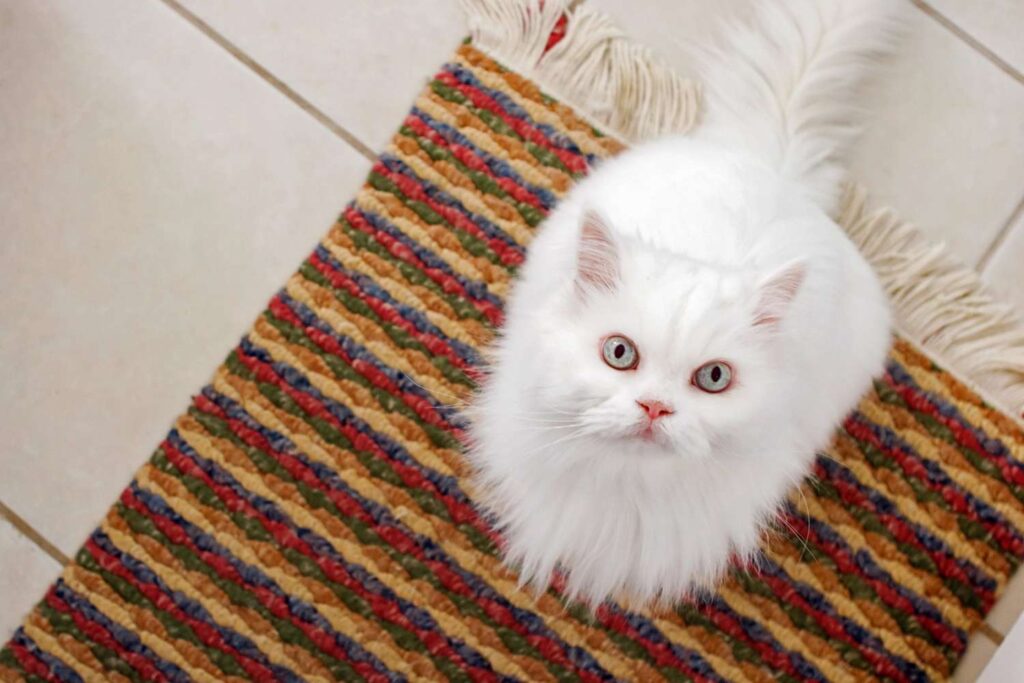In this article, you will learn how to teach tricks and commands to your Persian cat. We will explore different methods and techniques that can help you train your furry friend. From simple tricks like sitting and shaking hands, to more advanced commands like jumping and fetching, we will cover it all. By the end of the article, you will have a step-by-step guide on how to effectively train your Persian cat and have fun while doing it. So let’s get started and unleash your cat’s hidden talents!
Teaching Your Persian Cat Tricks and Commands
Introduction
If you are a proud owner of a Persian cat, you may have already experienced their unique personality and intelligence. Persian cats are known for their calm and gentle demeanor, making them great companions. But did you know that you can also train your Persian cat to perform tricks and commands? Training your Persian cat not only stimulates their mind but also strengthens the bond between you and your furry friend. In this article, we will explore the importance of training, the benefits it brings, and how to get started on teaching your Persian cat tricks and commands.
Importance of Training
Training your Persian cat is important for several reasons. First and foremost, it promotes their mental stimulation and provides a healthy outlet for their energy. Cats, including Persians, have a natural instinct to explore and engage in activities. By training them, you are giving them a constructive way to fulfill these instincts and prevent boredom.
Furthermore, training allows you to establish a positive and respectful relationship with your Persian cat. It strengthens the bond between you and your feline companion, as well as fosters trust and communication. A well-trained cat is also easier to handle during grooming, vet visits, and other necessary activities.

Benefits of Training
Training your Persian cat offers a multitude of benefits, both for you and your feline friend. Here are some advantages that come with teaching your Persian cat tricks and commands:
-
Mental Stimulation: Cats are intelligent creatures, and training provides mental exercise that keeps their minds sharp and active. A stimulated cat is a happy cat.
-
Bonding: Training sessions give you an opportunity to spend quality time with your Persian cat, strengthening your bond and deepening your relationship.
-
Better Behavior: Well-trained cats are more likely to exhibit desirable behaviors and are less likely to engage in destructive or problematic behaviors such as scratching furniture or biting.
-
Safety: Training certain commands, such as “come” or “stay,” can help ensure your Persian cat’s safety in potentially dangerous situations.
-
Enrichment: Learning tricks and commands provides a source of enrichment for your Persian cat, preventing boredom and promoting overall well-being.
Getting Started with Training
Before embarking on the training journey with your Persian cat, there are a few essential tips to keep in mind:
1. Patience and Consistency
Training a cat takes time and patience. Each cat is unique and may progress at their own pace. Be prepared to invest time and effort into the training process, and remain consistent with your methods.
2. Positive Reinforcement
Positive reinforcement is the key to effective training. Reward your Persian cat with treats, praise, and play whenever they perform a desired behavior or command correctly. This encourages them to repeat the behavior in the future.
3. Training Sessions
Keep training sessions short and frequent. Cats have short attention spans, so aim for sessions of around 10-15 minutes, a few times a day. Consistency is more important than duration.
4. Use Training Tools
Consider using training tools such as a clicker or target stick to aid in the training process. These tools can help with communication and timing, making the training more efficient.
With these tips in mind, let’s explore some basic commands and advanced tricks you can teach your Persian cat.

Basic Commands
Basic commands are the foundation of your Persian cat’s training. These commands are essential for their safety and well-being.
1. Sit
Teaching your Persian cat to sit is a fundamental command. Start by holding a treat close to their nose, then lift your hand slightly above their head. As they follow the treat with their gaze, their bottom should naturally lower to the ground. As soon as their bottom touches the ground, say “sit” and give them the treat. Repeat this process, gradually introducing the vocal command without the treat.
2. Stay
The “stay” command is crucial for keeping your Persian cat safe in certain situations. Begin by commanding your cat to sit, then hold your hand out towards them, palm facing them, and say “stay.” Take a small step back, then immediately return to your cat and reward them with a treat and praise if they remained in the sitting position. Gradually increase the distance and duration of the “stay” command.
3. Come
Teaching your Persian cat to come when called is essential for their safety and allows you to easily redirect their attention. Start by calling your cat’s name in a cheerful tone and rewarding them with treats and praise when they respond. You can also use a clicker to reinforce the behavior. Practice this command in various locations and gradually increase distractions.
Advanced Tricks
Once your Persian cat has mastered the basic commands, you can move on to more advanced tricks. These tricks not only entertain but also provide mental stimulation and challenge your cat’s problem-solving skills.
1. Fetch
Contrary to popular belief, cats can be trained to fetch just like dogs. Start by introducing a favorite toy and encouraging your Persian cat to play with it. When they grasp the toy in their mouth, provide positive reinforcement with treats and praise. Gradually, throw the toy short distances and encourage your cat to retrieve it. With time and practice, they will learn to bring the toy back to you.
2. High Five
Teaching your Persian cat to give a high five is an impressive trick that showcases their intelligence. Start by placing a treat in your hand and making a fist. Present your fist to your cat and let them explore it with their paw. As soon as they make contact with your fist, say “high five” and reward them with the treat. Repeat this process until your cat can confidently offer a high five without the treat as a lure.
3. Roll Over
Training your Persian cat to roll over is a fun and adorable trick. Begin by commanding your cat to lie down. Hold a treat near their nose and gradually move it towards their shoulder, encouraging them to roll onto their side. As soon as they complete the roll, say “roll over” and reward them with the treat. Repeat this process, gradually eliminating the lure of the treat.

Clicker Training
Clicker training is a popular and effective method of training that builds upon the principles of positive reinforcement. It involves using a small handheld device called a clicker to mark the desired behavior, followed by a reward.
1. What is Clicker Training?
Clicker training is a form of operant conditioning where a distinct sound, the click, is used to indicate to the animal that they have performed the desired behavior correctly. The sound of the click acts as a bridge between the behavior and the reward, making it easier for the cat to understand what they are being rewarded for.
2. How to Use a Clicker
To start clicker training, first, familiarize your Persian cat with the sound of the clicker. Simply click the device and immediately reward your cat with a treat. Repeat this process several times until your cat associates the clicker sound with a positive outcome.
Once your cat has successfully understood the association, you can begin using the clicker to mark behaviors you want to reinforce. Click the device at the precise moment your cat performs the desired behavior, followed immediately by a treat and praise. With consistent training, your cat will learn to associate the click with a reward and will be motivated to repeat the behavior.
3. Benefits of Clicker Training
Clicker training has several benefits for both the trainer and the cat. Some of these benefits include:
-
Clear Communication: The clicker provides a precise and consistent marker, making it easier for your Persian cat to understand which behavior they are being rewarded for.
-
Speeds Up Learning: The clicker serves as instant feedback, enabling your cat to quickly understand what they need to do to receive a reward.
-
Focuses on Positive Reinforcement: Clicker training is based on positive reinforcement, which helps build a strong bond between you and your Persian cat.
-
Versatile: Clicker training can be used to teach a wide range of behaviors and tricks, from basic commands to complex tricks.
Positive Reinforcement
Positive reinforcement is an essential aspect of training your Persian cat. By using rewards and praise, you can encourage your cat to eagerly perform desired behaviors and tricks. Here are some methods of positive reinforcement that can be effective during training sessions:
1. Using Treats
Treats are a common and effective way to reward your Persian cat during training. Find small, bite-sized treats that your cat enjoys and use them as positive reinforcement when they correctly perform a behavior or trick. It’s important to use treats that are specifically formulated for cats, as some human food can be harmful to them.
2. Using Praise
Alongside treats, verbal praise is another powerful tool for positive reinforcement. Cats respond well to a happy and encouraging tone of voice. When your Persian cat completes a desired behavior or command, shower them with praise and let them know they have done a great job.
3. Using Play
For some cats, play can be a significant motivator. Incorporate interactive play sessions into your training routine, using toys that your Persian cat finds stimulating and enjoyable. Engage them in play after they successfully perform a behavior or trick, making the play session a special reward for their efforts.

Patience and Consistency
Training your Persian cat requires patience and consistency. Here are some tips to help you stay on track during the training process:
1. Creating a Training Schedule
Establish a regular training schedule, with short but frequent sessions. Cats thrive on routine, so a consistent training schedule will help them understand what is expected of them and when to expect training time.
2. Rewarding Progress
Recognize and reward any progress your Persian cat makes, no matter how small. This positive reinforcement encourages them to continue learning and trying their best.
3. Dealing with Setbacks
It’s normal to face setbacks during training. If your Persian cat seems uninterested or resistant, take a step back and reassess your approach. Modify your training methods if necessary and be patient. Remember, training is a journey that takes time and effort.
Understanding Your Cat’s Behavior
To effectively train your Persian cat, it’s important to understand their behavior and communication signals. This knowledge will help you identify their needs and respond appropriately. Here are some key areas to focus on:
1. Body Language
Cats communicate through body language. Pay attention to your Persian cat’s posture, tail movements, ear positions, and eye contact. Understanding their body language will help you gauge their mood and emotions during training.
2. Communication Signals
In addition to body language, cats use vocalizations, such as meowing and purring, to communicate their needs and desires. Learn to distinguish between different vocalizations and respond accordingly. For example, a meow may indicate a request for attention or food, while purring denotes contentment.
3. Identifying Stress or Discomfort
While training your Persian cat, it’s crucial to ensure their comfort and well-being. Watch for signs of stress or discomfort, such as excessive grooming, hiding, or aggression. If your cat displays any of these behaviors, take a break from training and create a calm and safe environment for them.

Training Troubleshooting
During the training process, you may encounter some common challenges. Here are a few troubleshooting tips to overcome them:
1. Lack of Interest
If your Persian cat appears disinterested during training, it may be due to a lack of motivation or distractions. Ensure that the training environment is free from distractions, use higher-value treats, or try incorporating play into the training sessions to increase their engagement.
2. Distractions
Cats are naturally curious creatures and can easily get distracted by their surroundings. Minimize distractions in your training space and gradually introduce them as your cat becomes more focused and responsive.
3. Aggression or Fear
If your Persian cat displays aggression or fear during training, it’s essential to address the underlying cause. Aggression or fear can indicate stress or discomfort. Consult with a professional animal behaviorist or a veterinarian for guidance on how to address these issues safely and effectively.
Training Tools
Certain training tools can make the training process easier and more efficient. Here are a few tools that can aid in training your Persian cat:
1. Clicker
As mentioned earlier, a clicker is a valuable tool for clicker training. It produces a distinct sound that marks the desired behavior and serves as a clear communication tool between you and your Persian cat.
2. Target Stick
A target stick is a long stick with a soft, retractable tip that you can teach your Persian cat to touch with their nose or paw. It can be helpful for teaching more advanced tricks or for shaping specific behaviors.
3. Treats and Toys
High-quality cat treats, specifically formulated for training, should be an integral part of your training toolkit. Look for treats that are small, soft, and appealing to your Persian cat. Additionally, interactive toys can provide mental stimulation during training breaks or as rewards for your cat’s progress.
Training for Specific Tricks
In addition to the basic commands and advanced tricks mentioned earlier, there are many other tricks you can teach your Persian cat. Here are a few examples:
1. Jumping through Hoops
With patience and reward-based training, you can teach your Persian cat to jump through a hoop. Gradually raise the hoop to teach them to jump higher and follow the hoop with treats and praise.
2. Playing Dead
Teaching your Persian cat to play dead can be an entertaining trick. Begin by commanding them to lie down, then gently guide them onto their side. Reward them with treats and praise when they remain in the “playing dead” position.
3. Opening Doors
Persian cats are intelligent and can learn the trick of opening doors with proper training. Use a target stick to guide them to a door handle and reward them with treats and praise when they touch it. Gradually shape the behavior until they can open the door on their own.
Training Considerations for Persian Cats
When training Persian cats, certain considerations must be taken into account due to their specific breed characteristics. Keep the following factors in mind:
1. Gentle Approach
Persian cats are known for their calm and gentle temperament. Use a gentle and patient approach during training to avoid overwhelming or stressing them. Keep the training sessions calm and positive.
2. Avoiding Overstimulation
Persian cats may be more sensitive to stimuli, such as loud noises or sudden movements. Create a quiet and peaceful training environment, free from distractions, to prevent overstimulation during training sessions.
3. Physical Limitations
Due to their unique physical features, such as their long fur and flat face, Persian cats may have certain limitations. Be mindful of their physical comfort and ensure that training exercises do not strain their breathing or cause discomfort.
Training as Bonding
Training your Persian cat is not just about teaching them tricks and commands; it is also a valuable opportunity to build a stronger bond and deepen your relationship with your feline companion.
1. Building Trust
Training sessions create a positive and rewarding experience for your Persian cat, strengthening the trust they have in you as their caregiver. Bonding through trust is essential for a harmonious and fulfilling relationship.
2. Increasing Communication
Training provides a platform for effective communication between you and your Persian cat. As you learn to understand their body language and vocalizations, and they learn to respond to your cues, your communication will become more seamless and meaningful.
3. Strengthening the Human-Animal Relationship
A well-trained Persian cat is more likely to feel fulfilled and content, resulting in a stronger human-animal bond. When you invest time and effort into training your cat, you are investing in a long-lasting and fulfilling relationship.
Maintaining Training Results
Once your Persian cat has learned various tricks and commands, it’s necessary to reinforce their training to maintain the results. Here are some strategies for maintaining the training:
1. Reinforcement Sessions
Regular reinforcement sessions help your Persian cat retain what they have learned. Set aside time each week to practice previously taught commands and tricks, rewarding your cat for their continued success.
2. Reviewing Commands
Occasionally, review the basic commands with your Persian cat to ensure they remain responsive. This helps reinforce their understanding and keeps their training up-to-date.
3. Continuing Skill Development
Continue to challenge your Persian cat with new tricks and commands to further their skill development. This not only keeps their training exciting but also provides them with ongoing mental stimulation.
Conclusion
Training your Persian cat to perform tricks and commands is an enjoyable and rewarding experience for both you and your feline friend. By following the tips and techniques outlined in this article, you can embark on an enriching journey together, strengthening your bond and providing mental stimulation for your Persian cat.
Remember, training takes time, patience, and consistency. Enjoy the process of teaching your Persian cat tricks and commands, and celebrate their achievements. With dedication and a positive approach, you can unlock your Persian cat’s full potential and create a lifelong partnership built on trust and understanding.
Common Questions and Answers about Persian Cats:
-
Q: Are Persian cats friendly? A: Yes, Persian cats are known for their friendly and gentle nature. They make excellent companions and are generally well-suited for families and individuals.
-
Q: Are Persian cats easy to train? A: Persian cats can be trained, but it may require more patience and consistency compared to some other cat breeds. Their independent nature and calm demeanor may influence their response to training.
-
Q: How long does it take to train a Persian cat? A: The training duration varies for each cat. Some Persian cats may quickly grasp certain behaviors or tricks, while others may take more time. Consistency, positive reinforcement, and understanding your cat’s individual personality will help in the training process.
-
Q: Can Persian cats be trained to use a litter box? A: Persian cats are generally clean and fastidious by nature, making them good candidates for litter box training. Introduce them to a litter box early on and provide positive reinforcement when they use it correctly.
-
Q: Do Persian cats require special grooming? A: Yes, Persian cats have long, luxurious coats that require regular grooming to prevent matting and keep their fur healthy. Daily brushing, regular bathing, and eye cleaning are essential aspects of Persian cat grooming.
-
Q: Are Persian cats good with children and other pets? A: Persian cats are generally tolerant and adaptable, making them suitable for households with children and other pets. As with any introduction between pets, proper socialization and supervision are crucial.
-
Q: Do Persian cats have specific health concerns? A: Persian cats are prone to certain health issues, such as breathing difficulties due to their flat faces and eye problems. Regular veterinary check-ups and proper care can help address and manage these concerns.
-
Q: How can I keep my Persian cat entertained and mentally stimulated? A: Providing toys, interactive play sessions, puzzle feeders, and vertical spaces for climbing can keep your Persian cat entertained and stimulated. Engaging in training sessions and teaching them new tricks can also provide mental enrichment.
-
Q: Can Persian cats be trained to walk on a leash? A: Yes, with the right approach and patience, Persian cats can be trained to walk on a leash. Start with introducing them to a harness gradually, and then gradually introduce outdoor walks in safe and controlled environments.
-
Q: How can I ensure my Persian cat’s happiness and well-being? A: Along with training, maintaining a healthy diet, ensuring regular veterinary care, providing a stimulating environment, and showering them with love and attention are important for your Persian cat’s happiness and overall well-being.
